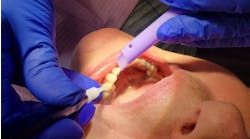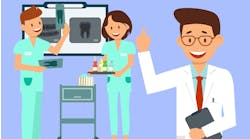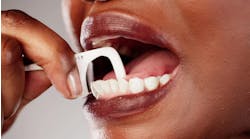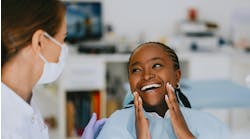It’s spring and bears have emerged from their winter slumber. I grew up in bear country in the Sierra Nevada mountains and was often told that bears in the spring should be avoided. As a camper and backpacker who has spent many days in the mountains, I can tell you this is true. In popular backcountry areas, warning signs alert campers to be prepared and secure their resources from bears. When bears emerge, they’re hungry and consume lots of food, cause damage to campsites, and slash their way back into the world until things stabilize and summer brings their much-needed resources for survival.
Dentistry has seen amazing growth, especially during the last 10 years. We may forget that our market has been growing a long time and has seen many upward and downward cycles. Even though we’ve seen our portfolios grow and our dental practices soar, it’s easy to forget how fortunate we are as a profession. Like many of you, I was in practice during the last recession, which dentists weathered well. But they had strategies and plans to get them through. This current pandemic has unleashed upon us our very own spring and with it a tremendously uncertain time. This is an unprecedented event, and nobody knows what to expect in the coming months and years. But we can look back on history to get an idea of what we can expect.
I’ve examined data and literature based on market corrections, bear markets, and more recently, the dental profession between the years of 2007 and 2010. I’ve examined hundreds of dental practices as well. The Health Policy Institute (HPI) has also proven to be valuable in evaluating current and past events with its large amounts of data and information. As this information is released, it will be incredibly helpful as we determine how to adjust our paths.
In the meantime, many dentists are sitting at home wondering what to do. Here are three things dentists can do now to emerge triumphantly from this pandemic-induced recession.
How dentists can successfully reemerge
Data produced from multiple studies between 2007 and 2010 indicate that we may certainly experience not only a correction but a bear market. In the recession of 2007 through 2009, dentistry saw a decline followed by steady growth. More specifically, there was a down year of negative to zero growth followed by a compounded annual growth rate (CAGR) of about 2%. Obviously, 2% growth is still negative and not desirable. However, after about two years following the last recession, dentistry grew at a rate of 4% or higher (depending on the study) and in recent years has seen a CAGR significantly higher. In fact, even the American Dental Association Health Policy Institute projected CAGR to increase in 2020. Then, COVID-19 happened.
So, what does that mean for us now? Clearly, many experts agree that our stock market was due for a correction. Now, our market is officially in a government-induced recession. What I mean by this is that typically a recession is driven by economic forces, but this particular recession is the result of mandatory shutdowns of our economy. This plays out to be both good news and bad news.
First, the bad news: nobody knows exactly how the public-at-large is going to respond to the pandemic and what normal life is going to look like. The ADA and the CDC has already published guidelines that suggest our personal protective equipment (PPE) requirements will increase to include face shields, disposable gowns, head coverings, and masks that are all better suited to protect us from aerosolized pathogens. Currently, N95 and N100 masks are very difficult to acquire.
As a profession, it will be important for us to educate the public and our employees that we always have and always will take universal precautions to protect ourselves and the people we serve. Having said that, intangible aspects of our practices have been affected. We will need to explore additional safety measures such as ventilation systems that remove aerosolized material from the air (visit sentryair.com), routines that limit interaction between patients and promote social distancing, and new schedule templates or shift work for our teams.
So, the bad news is that we are simply not sure what long-term effects of the pandemic there will be on our profession and everyday practice life.
Now the good news: The good news is the economy. But it doesn’t seem very good does it? Here is what we know. While the stock market may have been primed for a correction, it may not have been ready for a full-blown recession. Many aspects of our economy were very strong before being forced to shut down. This means that the momentum we had before the pandemic-forced closures could be helpful in reigniting the economy.
While we may currently be in a recession due to reduced business, the business is still out there despite some irreversibility that has been introduced by the federal government and other economic factors. Historically, we have seen 12 to 18 months of decline followed by a steady increase in growth with a return to our previous business levels in 24 to 36 months. If history repeats itself, in the next 12 to 18 months we will see about a 25% reduction in crown and bridge procedures and see a complete recovery of preventive procedures during the next year or so.
The bottom line is that our businesses will recover if we are economically responsible and diligently prepared. For some, this is great news, and for others this is horrible. Undoubtedly there will be a period of mergers and acquisitions that will fuel the growth of centrally owned and managed dental groups. There will be an opportunity for consolidation of dental offices as well as dental labs. But properly positioned dental practices will emerge triumphant in the next 24 to36 months.
Now is the time to differentiate your practice, be prepared, and keep your resources where the bear cannot get to them. Be on alert. It’s spring and the bears have been awakened by COVID-19, but summer always arrives and with it, the much-needed resources for survival.
Andrew Goldsmith, DDS, graduated from the University of Nevada Reno in 1992 and Marquette University School of Dentistry. He completed a two-year general practice residency at the University of Colorado, where he was a part-time associate professor and established a successful dental practice in Colorado Springs. After 11 years in private practice, Dr. Goldsmith sold it to help establish a group of dental practices dedicated to preserving independent practice dentistry, a group that now has over 500 locations. Dr. Goldsmith has published articles in multiple journals and spoken to dentists around the world. He currently practices dentistry in Houston, Texas, and operates Process23.com, which offers online CE and practice management education.
Editor's note: For updates regarding the COVID-19 crisis and dental office shutdowns, visit the DentistryIQ Coronavirus Resource Center.






